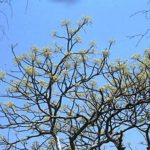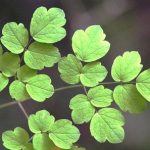TREE LIFE
September 1999
MASHONALAND CALENDAR
Tuesday 7 September. Botanic Garden Walk at 4.45 for 5 p.m. We will meet Tom in the car park and continue with the Euphorbiaceae family. There will be a guard for the cars.
Sunday 19 September. Mbagazewa, a kopjie of historical as well as botanic interest in the Raffingora district is our venue. We do not intend to climb the steep slope to the top – there is a great deal of vegetation around the base of the kopjie but the historical importance of Mbagazewa will be discussed before the walk.
Saturday 25 September. Mark will lead his walk in Ruwa Scout Park, which on our last visit in June 1993 proved to have a great deal of interest including a stream with a variety of water plants. Directions: Take the Mutare Road out of Harare and the entrance to the park is opposite the 20.5 km peg. Meet at 2.30 p.m.
Tuesday 5 October. Botanic Garden Walk.
MATABELELAND CALENDAR
Sunday 5 September. Matopos, Nswatugi area, but as Nat. Park fees have just gone up we may need to revise this to an adjacent, free area. Meet at Girls’ College car park (Pauling Road entrance) at 8.15 for 8.30 sharp departure.
SUNDAY 18th JULY 1999 – RUZAWI SCHOOL
Our July Sunday meeting was held in the miombo woodland on one of the kopjies near Ruzawi School, just outside Marondera. Serious botanising was delayed by excellent tea produced by our hosts Maureen and Buck Williams. No objections were raised to this unexpected bonus, which provided an opportunity to look at the aloe garden, which was in climax blossom, with an impressive variety of different species, and of course a variety of attendant sunbirds.
From the school, we followed a stretch of the old coach track to the kopjie. Buck Williams set the ball rolling by drawing our attention to the Old Man’s Beard and other lichens that covered many of the trees. These reflected both the higher rainfall in the east of the country, and moisture from condensation of mists around the kopjies. It was noted that lichens are in fact a symbiotic association of an alga and a fungus. This association allows both life forms to survive more extreme conditions than would be possible individually. The lichens on the trees tended to be the prominent leafy variety (such as Old Man’s Beard). The crustose lichens, sometimes vividly coloured, are a very characteristic feature of the Zimbabwe granites. My notes record that lichens can reach considerable age, with specimens up to 10 000 years old recorded in the Arctic. If I understood correctly, this would make them some of the world’s oldest living plants. But apparently not the oldest. Saltbushes in the USA have apparently been dated at 14 000 years. An interesting aside was that lichens growing on the famous Easter Island statues were used to provide an estimate of the time that they were sculptured.
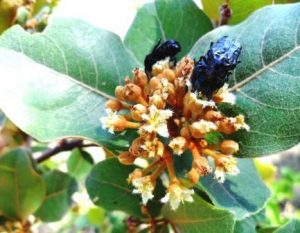
Psorospermum febrifugum. Photo: Bill Clarke. Source: Flora of Zimbabwe
Phil Haxen found a specimen of Psorospermum febrifugum and informed us that traditional belief has it that being caught burning the wood singles you out as a ‘witch’. In similar vein, Bob Drummond (Trees of the central Watershed) notes that domestic strife ensues if the wood is burned. Coates Palgrave records that wearing a piece of the plant in your hair will make you invisible to wild animals. Don’t mess with Psorospermum febrifugum.
Among the usual suspects rounded up were the Mnondo Julbernardia globiflora, which was common, and the Msasa Brachystegia spiciformis, which was far less abundant. A conspicuous feature of the latter was the large number of galls on the leaves, each of which housed small green lava, a couple of millimetres in length. The galls did not appear to occur on any of the other trees in the area, but in my experience are not typical of Msasas in general. Any information as to the identification of the lavae and its significance would be welcomed.
We encountered a number of specimens of the Ginger Bush Tetradenia brevispicata that were just beginning to blossom. These were incidentally already making their generous lavender displays in Harare – presumably coming out earlier in part in response to watering, and possibly also the somewhat lower altitude.
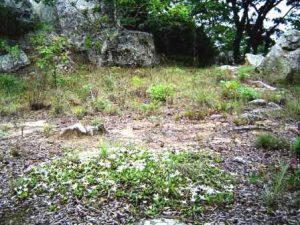
Leptactina benguelensis. Photo: Bart Wursten. Source: Flora of Zimbabwe
A curiosity for me was the Ivory Carpet Leptactina benguelensis. The woody portions of the plant occur underground, and as a result the leaves appear to be growing directly out of the ground. We were too early to see the fragrant flowers typical of the species.
We found a number of specimens of Faurea saligna, and one of Faurea speciosa, with its broader leaves. Except, alas, Faurea speciosa is no more, and according to the SASOL Protea book is now Faurea rochetiana.
A conspicuous species was Indigofera rhynchocarpa, with its characteristic elongate “hockey-stick” pods. Hymenodictyon floribundum was also seen, but unfortunately lacked its showy cabernet autumn leaves. A specimen of Sericanthe andongensis (originally Neorosea andongensis) was identified by its small fragrant stellate white flowers and one early globose fruit with a persistent tubular calyx.
We saw a number of specimens of Lopholaena coriifolia, with its characteristic waxy leaves that feel cold to the touch, and silky seed-heads. These are typical pioneer plants in overgrazed areas.
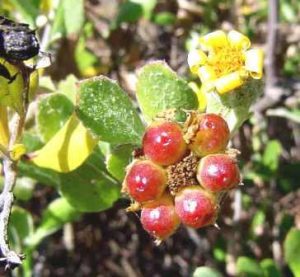
Chrysanthemoides monilifera. Photo: Bart Wursten. Source: Flora of Zimbabwe
Chrysanthemoides monilifera, a low shrub, with attractive yellow daisy-like flowers and stalks covered with white cobweb-like hairs, was found growing in a rocky outcrop, just as the books say it should. This species is found in the dunes of the eastern coastline, from Cape Town to Mozambique, but also extends into the eastern mountain ranges. The isolated Zimbabwe population occurs in the eastern highlands and extends westwards into the higher areas of the central watershed. It has become established in Australia, where it is considered an undesirable alien.
Pleurostylia africana (the Northern Coffee Pear) was identified by its glossy drooping leaves, arranged roughly at right angles. It is now considered to be synonymous with Pleurostylia capensis, which occurs along the east coast of South Africa and as an isolated population in the Northern Province.
Other species seen were Pittosporum viridiflorum, Ozoroa insignis and an unidentified Ochna.
At about this point, during a lapse in concentration, the scribes lost Mark Hyde, which accounts for the fact that the list of species recorded is not considerably longer. But it can be noted that on the way down, without Mark, they did record Pavetta schumanniana. It is of course possible that they were just not concentrating on the way up.
Root note:
Buck Williams mentioned the following: Lunch in the garden with a large flock of very excited Spotted-back Weavers. Masses of spectacular aloe blooms and sunbirds.
The afternoon bit: Buck Williams noted this interesting feature with Msasa – a deeper red hue to the leaves when cold whereas in warmer conditions the colour appears considerably paler.
Mopane – little or no seeding after a drought, followed by profusion the next season. From 30-odd years of observation it seems that the trees can somehow anticipate the seasons.
Ruzawi School
The main building which forms Ruzawi School dates back to the early 1930’s, however, the area on which the school now stands was a gathering point for the settlers caught up in the uprising in 1896. John Clatworthy, who has studied the history of the Marondera area, gave an impromptu talk on the subject and mentioned a number of individuals, a number of whom died during this traumatic time. Some gave their lives doing acts of bravery while others were caught off guard. A short distance from the school buildings a small cemetery contains a number of metal crosses erected in memory of those who died in this period but, unfortunately, there are no names affixed, but the more recent tombstones complete with some flowering Aloe chabaudii are of those directly related with the development of the school. Some back issues of Heritage, the History Society Journal, carry detailed accounts of this period of the country’s history.
Back at the house whilst quaffing sandwiches and tea, surrounded by the magnificent flowering Aloes we were constantly aware of the large flock of very excited Spotted-backed Weavers feeding on the seed put out by Buck and Maureen. It was, in fact, like being in a natural aviary. For the afternoon, different terrain to observe, being level sandy ground and a mature plantation of exotics – Eucalyptus sp. and Pinus sp. Of the pines, two distinct species were obvious – the stiff erect needles with a yellowish tinge and the coarse bark indicate Pinus roxburghii are an easily noted feature, whilst droopy bright green needles of those of Pinus patula, which I’m assuming most people know reasonably well.
Andy Moore has covered most the species seen and Mark took home a fairly full bag of herbaceous material, which often indicates an enjoyable day was had by all. Many thanks to Buck and Maureen for hosting the outing and to John Clatworthy for a most informative talk on the history of the area.
–Andy MacNaughtan
CONIFER WALK: 7th AUGUST 1999
With Tom away, Lyn Mullin kindly agreed to lead a Saturday morning walk looking at conifers at the Forest Research Centre in Orange Grove Drive, Highlands. Lyn led a similar walk on 5th March 1996 and it was a pleasure to be taken though it again. The concepts were much more familiar the second time around.
History of the Forest Research Centre
Lyn first outlined a short history. The first use of the area was as a Government Nursery in 1903, which grew plants for sale. In those days, the site was a long way out of the built-up area of town. It was abandoned in 1905 but came back into use in 1907 and a number of the current trees can be traced back to that year. In 1909, the nursery moved again to where Research and Specialist Services is now but by 1912 it was back again and it has remained in continuous use ever since.
Taxonomy
From the literature handed out by Lyn, there are 4 orders in the Gymnosperms, namely the Ginkgoales, Pinales, Taxales and Cycadales. Of these, we did not consider the Cycadales; there are no Taxales at the Forest Research Centre and there is only one species in the Ginkgoales, namely Ginkgo biloba.
This, the Maidenhair Tree, has a long fossil record and survives today in a small region of southern China. It has also been cultivated for centuries in temple grounds. It is a bit unusual in being a deciduous conifer and instead of having cones it has nut-like fruits. The leaves are fan-shaped, sometimes 2-lobed, with parallel forking veins.
The main order studied was therefore the Pinales, and we looked at representatives of 4 families: Araucariaceae, Cupressaceae, Pinaceae and Taxodiaceae.
Araucariaceae
Apart from the very rare genus Wollemia, which was only discovered in 1994, there are two genera, both of which occur in Zimbabwe, Agathis and Araucaria. Lyn explained that technically they are separated by whether the seed is free of the cone scale (Agathis) or united (Araucaria).
Agathis is represented only by the Kaurie Pine, Agathis australis, which has broad flat leaves, some of which are opposite. It is of course totally unlike a pine in the sense of the genus Pinus.
Araucaria, on the other hand, is well represented as a planted genus in Zimbabwe. Two species with a striking elongated crown are Araucaria columnaris (usually curved) and Araucaria heterophylla (always straight). The latter is the true Norfolk Island Pine and is very rare in Zimbabwe, although a few specimens do occur on the corner of Glenara Avenue South and?? Manica Rd. The species which everyone calls the Norfolk Island Pine is Araucaria columnaris, the Cook Pine, which actually comes from New Caledonia.
Both of the above Araucaria has awl-shaped leaves, whereas the others we saw all had flat leaves. Araucaria hunsteinii, from New Guinea, is actually somewhat intermediate between the two types. Araucaria cunninghamii, the Australian Hoop-pine from Australia and New Guinea, is a very prickly species with rigid leaves.
Araucaria bidwillii (the Bunya Pine from Australia) has broad fleshy leaves. It has a very large cone and the seeds are edible. The only other one we saw was Araucaria angustifolia, another broad leaved species, this time from Brazil; it has its branches in regular whorls whereas Araucaria bidwillii is less regular. I understand a former name for angustifolia is Araucaria brasiliensis. Both of these species are commonly planted in Harare.
Cupressaceae
We next looked at some Cupressaceae, namely Cupressus glabra, which has glaucous foliage and bark peeling off in long vertical strips. It comes from SW USA and Mexico and is commonly sold as Cupressus arizonica, a species which it very closely resembles and is also commonly planted around Harare.
Lyn mentioned that the species of Cupressus commonly hybridise, making identification difficult.
The family typically has small scale-like leaves and to me the genera tend to look superficially similar.
Later we saw the very similar-looking genus Callitris and specifically Callitris endlicheri. Lyn mentioned that the fruits afford a distinction: Callitris has 3 large and 3 small scales; Cupressus 2 large and 2 small scales and Widdringtonia (also superficially similar) has 4 scales.
We also looked at Platycladus orientalis, (Thuja orientalis) that has the typical scale-like leaves of the family; in this case the foliage is flattened and held in a plane.
Pinaceae
The biggest family in Zimbabwe is the Pinaceae. Space forbids listing the numerous species of pine we were shown. Of interest also was a worldwide distribution map showing that Pinus is almost entirely a northern hemisphere genus. Vast swathes of N America, N Europe and Russia are covered in a few species of pines, but the richest area for pines, where new species are still being found, is in C America and specifically parts of Mexico. This fact was certainly a surprise to me. It also accounts for the number of species with Aztec-sounding names.
In addition to pines, we also were shown a small Cedrus deodara, which is a cedar. Lyn mentioned that the three species Cedrus atlantica, Cedrus brevifolia and Cedrus libani are all somewhat similar to Cedrus deodara and some authorities would lump them into one taxon, Taxodiaceae.
Finally, the Taxodiaceae. Only two species were looked at here. One was Taxodium distichum, the Swamp Cypress, which is another deciduous species. This comes from the S and SE USA. It has quite striking bronzy foliage as the leaves fall.
Cunninghamia lanceolata, the Chinese Fir, has leaves that are narrow and grey beneath with clear lines of stomata. It does indeed come from China and has highly durable wood used for making coffins. One very odd feature of it is the way the shoots continue to grow right through the terminal cone!
Once again, our thanks go to Lyn for leading such an interesting walk.
-Mark Hyde
TREES OF KNOWLEDGE
The oldest known fossilised forest in the world has recently been discovered in Spain by a team led by Alfonso Sopena of Spain’s Economic Geology Institute, writes Maxine-Fay Miller. The fossilised conifer trees found in the Guadalajara region, northeast of Madrid, are estimated to be 280 million years old. They were buried millions of years ago by volcanic emissions and preserved by a process known as silicification or petrification. Silica, released from weathering volcanic ash, is gradually incorporated into decaying wood, producing a long-lasting solid structure. This Petrified Forest may hold clues to past climatic changes, particularly the global warming which the trees experienced in the Carboniferous era, and may help to interpret current climatic changes.
BRACHYSTEGIA – ZIMBABWE’S PRIDE
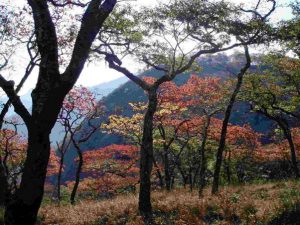
Brachystegia spiciformis. Photo: Bart Wursten. Source: Flora of Zimbabwe
Have you seen The Msasa trees burn
Red to green?
A cooking flame
Between the sun’s blaze
And our tired eyes.
R KNOTTENBELT – SPRING
Try to imagine, if you can, Zimbabwe without its Msasa to bring the bush to life with a brilliance of reds and yellows and pinks and fawns and green when the new leaves break out in August and September of each year.
Brachystegia spiciformis Msasa, or more correctly the Shone musasa is perhaps the best-known and best-loved native tree in Zimbabwe, and although its blaze of glory in spring is all too brief, those few short weeks of colour are eagerly awaited by all. The tree loses its leaves at the very end of winter, and soon afterwards there is the annual splendour of the spring flush, when all the colour comes from the young leaves alone. The flowers are inconspicuous, but their sweet scent is another of the tree’s great attractions.
It is not often that one will find a really big Msasa, but it does come in a wonderful variety of shapes. In Zimbabwe the tree may reach a height of 30 metres, but usually it is short of bole, with heavy branches that spread upwards and outwards to give the crown a rounded, sometimes flattened, sometimes layered appearance. It makes a fine shade tree, and many good natural specimens have been jealously preserved in urban gardens and around farm homesteads.
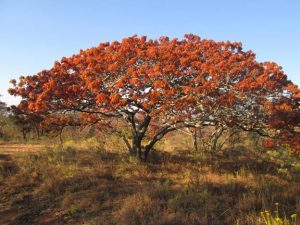
Brachystegia spiciformis. Photo Ann Sinclair.
Brachystegia comprises about 30 species, eight of them Guinea-Congo forest trees whose timber goes under the trade name of okwen, and the rest major components of the deciduous (miombo) woodlands of eastern and south-central Africa. There are seven named species of Brachystegia in Zimbabwe, and one that has yet to be given its scientific name. The brilliance of the spring flush is common to all of them. Four of these species, together with the more distantly related Mnondo, or munhondo, Julbernardia globiflora, dominate the woodland vegetation of the highveld; three others, including the unnamed species, occur only in the hot northern and south-eastern lowveld; and one is confined to the mountains of the eastern border. Julbernardia does not occur south of the Limpopo River into South Africa, but it is present in all our other neighbouring territories. The very hot, dry lowveld of the Limpopo Valley probably constitutes too great a barrier to the spread of the Julbernardia into South Africa, despite the presence of Msasa a long way south in Mozambique.
Brachystegia spiciformis is the most widespread of the eight species in Zimbabwe, and it is possibly because of this that it was given its Shona name. Musasa is also the Shona word for a temporary camp or an easily erected shelter, and since this tree was so common and supplied both poles and a very strong bark rope, it would have been much in demand when the people moved into a new area and started erecting their homes or, initially, their temporary camps. To this day Msasa supplies most of the material required for traditional dwellings and storage huts, and the tree’s bark also contains tannin that has been used for treating hides. Msasa is most common in regions receiving an average annual rainfall in excess of 750 mm; where the average rainfall is less than 750 mm Msasa becomes a less common component of the miombo woodland, particularly in the shallower soil types. It will, however, grow to quite large sizes in the relatively low rainfall of the north and northwest of Zimbabwe, where the prevailing soil is deep sand; this is because its strong root system can tap moisture at considerable depth in such soils. It is in this region that the tree is known as igonde, a name that was possible derived from the family name of the Shona chief in the Chinhoyi area, Nemakonde, who seemingly had great influence with the Ndebele people. Msasa-dominated woodlands are associated with a wide range of arboreal and terrestrial orchids and fungi, and they are also very important habitat for our highveld birds.
The next most common species is Brachystegia boehmii, Mufuti or mupfuti, sometimes also known as Prince-of-Wales feathers. This is a tree of the warmer and drier sites, often on poorly drained soils and rocky slopes, but it is also found with Msasa and Mnondo. It is very common in the north of the country near the edge of the Zambezi escarpment. This tree is usually smaller than Msasa, probably because it generally occupies harsher sites, but occasionally it grows to a height of 16 m. Its inner bark provides perhaps the strongest and most pliable cord or rope of any native tree in Zimbabwe.
The beautiful Mountain Acacia, Brachystegia glaucescens, or muunze in Shona, graces the rocky kopjies of the central and eastern parts of the country, but is less widespread in the west. The coppery colours of its spring flush are a striking feature of this species, and it is also easily recognized by its smooth, light-grey bark.
The Escarpment Brachystegia, Brachystegia allenii, and the Blue-leaved Brachystegia, Brachystegia manga, are species from the north that reach their southern limits in the hot, dry country of the Zambezi escarpment. They are both small and medium-sized trees and are not well known in Zimbabwe.
Brachystegia utilis is a common species at medium and low attitudes along the eastern border and in the northeast of the country. It somewhat resembles Brachystegia boehmii, and for this reason is known as False Mufuti.
Brachystegia microphylla, the Small-leaved Brachystegia, is a little-known species from the central part of the eastern border mountains, where it is a constituent of the deciduous woodland. Its leaves may have as many as 50 pairs of fine, slender leaflets.
Torre’s Brachystegia, which does not yet have a scientific name, is found in almost pure stands on rocky outcrops and hills in two widely separated regions in Zimbabwe, one in the extreme northeast and the other in the extreme southeast. There is some doubt about its status in the genus, and it requires further study.
The Brachystegia are an important part of Zimbabwe’s heritage of trees. They dominate the woodland cover of the main watersheds, and are thus essential to the ecology of the highveld and the protection of the country’s water supplies. And when we talk of Zimbabwe’s diminishing woodlands we are really talking about the disappearing Brachystegia. Try to imagine Zimbabwe without its Msasa.
-Lyn Mullin
NEEM – The Natural Solution
Multipurpose trees, such as Neem Azadirachta indica, can provide numerous functions in farming and forestry. Examples of multiple functions and products to look for in trees are:
Erosion control; soil fertility improvement; nitrogen fixing; shade, wildlife habitat; mulch or green manure; pest control; animal fodder; living fence; food; medicine; tannins; dyes; soaps; cosmetics; bee forage; farm timber; carving wood.
Examples of outstanding multipurpose trees include Jackfruit (Artocarpus heterophyllus), Leucaena (Leucaena leucocephala), Coconut (Cocos nucifera) Mango (Mangifera indica), Peach Palm (Bactris gasipaes), Tamarind (Tamarindus indica), and Neem (Azadirachta indica). Not all are necessarily suitable for Zimbabwe, but Neem will certainly grow here.
Neem is a native of the dry forests of India, Pakistan, Sri Lanka, Malaya, Indonesia, Thailand, and Burma, and is a tree crop with great potential in many low-altitude areas in Africa. Farmers as far afield as Australia, Hawaii, Florida, and South America are growing it commercially for use in pesticide manufacture. The International Centre of Insect Physiology and Ecology (Box 30772, Nairobi) has developed a Neem awareness project to promote the use of the crop for human and veterinary medicines, cosmetics, and building timber. Neem has a complex action, which makes it almost impossible for insects to develop resistance, and there is a growing world market for the active ingredient, azadiractin.
Farmers will no doubt want to know the commercial potential of the crop before making an investment in it – with pyrethrum there was, sadly, a slump in the market when chemical companies began producing synthetic pyrethrums. Although azadiractin has been produced in the laboratory, it is an expensive and tedious process, and the Neem tree is considered the best “factory”.
Neem will grow on degraded soils and has been used for reclamation in the Sahel. Australia already has 100 000 Neem trees in plantations. It will grow under hot and dry conditions, but does not tolerate frost. Neem leaves are generally unpalatable to livestock (except goats!), and the tree also produces termite-resistant poles, a serviceable hardwood timber (it belongs to the true mahogany family, Meliaceae), medicines, fertilizers, and neem oil.
Reproduced with modifications from the PERMACULTURE VILLAGER, Issue No. 7, Summer 1998).
Neem is currently under trial by the Forestry Commission in various parts of Zimbabwe. Seed can be obtained from the Forest Research Centre in Highlands (February – April) but its viability is very short and it must be sown within 2-3 weeks of collection. Plants are sometimes available from the Forest Research Centre.
-Lyn Mullin
SEARCHING FOR A CURE
They are ‘Searching for a Cure: Conservation of Medicinal Wildlife Resources in East and Southern Africa’ by Nina Marshall, and ‘South Africa’s Trade in Southern African Succulent Plants’ by David Newton and Justine Chan.
The World Health Organization estimates the 80% of the world’s population relies on traditional medicine to meet their daily health requirements. Traditional medicine is thus critical to health care. The TRAFFIC study identified 102 medicinal plants and 29 medicinal animal species that are used to such an extent that they have become priorities for conservation. The report includes a variety of recommendations, including actions for specific species and increased collaboration with traditional healers’ associations to promote propagation and public awareness.
The southern African subcontinent hosts the richest and most diverse flora in the world. Of a total of 5128 species and varieties, 2227 were found advertised in plant catalogues, and it was clear that many of these were being traded illegally. In many cases the biggest threat is habitat destruction.
These two documents can be obtained from Endangered Wildlife Trust (South African telephone number 011 04861102).
(Reproduced from FORESTRY FOR A SMALL PLANET, Issue No 33, Summer 1998.)
-Lyn Mullin
To those who ask about growing Baobabs – this year, because my first plantings were a waste of time and space, I opened another pod, soaked off all the pith and then ‘forgot’ the seeds in the oven at 140ºC for over an hour – and have had the best results ever from that species so far – about 40% germination. On the other hand, Olea europaea only germinated after I had stored the seed in the fridge for a few days.
They keep us guessing!
-Ann Bianchi.
ANDY MACNAUGHTAN CHAIRMAN


